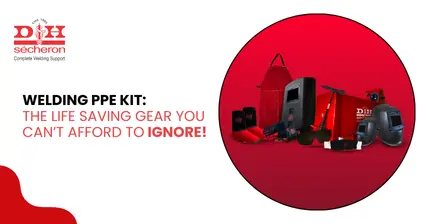Did you know that there are more than 3500 different grades of steel in the world? While all these grades have applications in some way or other, carbon steel and alloy steel are the most commonly used metallic materials in welding.
Let’s understand them in detail.
Carbon Steel
Carbon steel is an alloy of iron, carbon, silicon, manganese and other elements. However, the carbon amount is very high and other elements are in very low proportion. It is stronger and more durable than stainless steel. Stainless steel is an alloy of a minimum of 10.5% chromium.
Carbon steel has the following characteristics:
Less resistance to corrosion
High strength
Low weldability
Low melting points
Low ductility
It can be further categorized into three main groups:
Ultra-Low Carbon Steel: It has very low carbon, usually less than 0.1%.
Low Carbon Steel: It has carbon up to 0.3%.
Medium Carbon Steel: It has carbon in the range of 0.31% and 0.6%.
High Carbon Steel: It has carbon of more than 0.6%.
Low Alloy Steel
Low alloy steel is similar to carbon steel. However, alloy steel composition has a high percentage of extra alloy elements such as chromium, molybdenum, and others.
The alloy steel properties are as under:
Better corrosion resistance than carbon steel
Low strength as compared to carbon steel
High weldability
High melting point
High ductility
What is Low Alloy Steel Used for?
Alloy steel applications can be found in electric motors, pipelines, power generators, aircrafts, gears, spindles, auto parts and transformers.
The classification of alloy steel fall under two categories:
Low Alloy Steel
Low alloy steel contains a low amount of alloy elements. It has better mechanical properties than basic carbon steel. The key purpose of low alloy steel is to increase the hardenability of steel. This ensures optimization of mechanical properties and toughness after they undergo heat treatment.
High Alloy Steel
High-strength low-alloy steel, also known as HSLA, contains a high amount of alloy elements. It is designed to provide higher corrosion resistance and improved mechanical properties than normal carbon steel. The high strength low alloy steel composition has specific mechanical properties rather than chemical properties.
There are various other types of alloy steel:
Microalloyed steel
Advanced high-strength steel (AHSS)
Maraging steel
Tool steel
How to Choose Alloy Steel Grades?
When choosing alloy steel grades, you need to bear the following factors in mind:
Formability
Weldability
Machinability
Corrosion resistance
Need for the heat treatment process
Tensile strength
The choice of carbon and low alloy steel depends on the welding requirements. You can get buy good quality carbon and low alloy steel from DnH Secheron, India’s leading welding material manufacturer.
11 May 2025 | Welding
An In-Depth Exploration of Low-Alloy Steel: Your Comprehensive Guide
11 May 2025 | Welding
Nagpur - Bori - Tuljapur Road MSH-3 in Yavatmal District (Maharashtra)
11 May 2025 | Welding
Guidelines to Understand Gas Welding: Applications, Advantages & Disadvantages
11 May 2025 | Welding
3 Tips for Finding the Best Mild Steel Electrode for Your Application
11 May 2025 | Welding
How to Select the Right Welding Filler Wires for Stainless Steel Welding?
11 May 2025 | Welding
Building the Narendra Modi Stadium with Norma V and Autotherme-1 Electrodes
11 May 2025 | Welding
Low Alloy Steel Welding in a (PEB) Pre Engineered Building Structure
11 May 2025 | Welding
Welding Rods: Different Types and Tips for Properly Storing and Handling
11 May 2025 | Welding
Tips for Flawless Welds with Stainless Steel Electrodes: Pros and Cons
11 May 2025 | Welding
Exploring Applications and Benefits of Stainless Steel Welding Electrodes
11 May 2025 | Welding
Welding Basics: Joining Metals with Heat and Pressure - A Beginners Guide
11 May 2025 | Welding
Distinguishing Low-Alloy Steel from High-Alloy Steel: Understanding the Variations
11 May 2025 | Welding
Hard Facing Wire - Understanding the Process and Achieving Optimal Result
11 May 2025 | Welding
Exploring the Advantages of Stainless Steel Electrodes in Welding Applications
11 May 2025 | Welding
Weathering Steel vs. Traditional Steel: A Comparative Analysis of Performance
11 May 2025 | Welding
Choosing the Right Welding Rod: Why 6013 Electrodes Might Be Your Ideal Option
11 May 2025 | Welding
Why 7018 Electrodes Are Preferred for High-Strength Welds in Pipeline Construction
11 May 2025 | Welding
Filler Wire vs. Stainless Steel Filler Wire: Understanding the Key Differences
11 May 2025 | Welding
Exploring the Impact of Filler Material on Welding Quality and Durability
11 May 2025 | Welding
Choosing the Right Cast Iron Electrode for Different Welding Projects
11 May 2025 | Welding
Top Advantages of Cast Iron Electrodes for Industrial Welding Applications
11 May 2025 | Welding
Key Benefits and Challenges of Using TIG Welding in Industrial Projects
11 May 2025 | Welding
5 Reasons Why 7018 Electrode is the Gold Standard for Welding Professionals
11 May 2025 | Welding
Top 5 Advantages of Flux Cored Arc Welding for Heavy-Duty Applications.png)
11 May 2025 | Welding
Lotherme-601: A Game-Changer for Restoring Shoulder Pins in Heavy Machinery
11 May 2025 | Welding
How D&H Sécheron Helped Repair a Rotary Kiln’s Cooler Section with LoTherme 352
11 May 2025 | Welding
Piston Repair for Mining Industry: Cost-Effective Solutions with LoTherme 468.webp)






.jpg)







































.jpg)
.jpg)

.jpg)

.jpg)





.jpg)
.jpg)
.jpg)



.webp)
.jpg)
.jpg)
.webp)
.jpg)






















.png)



.webp)

.webp)
.webp)



